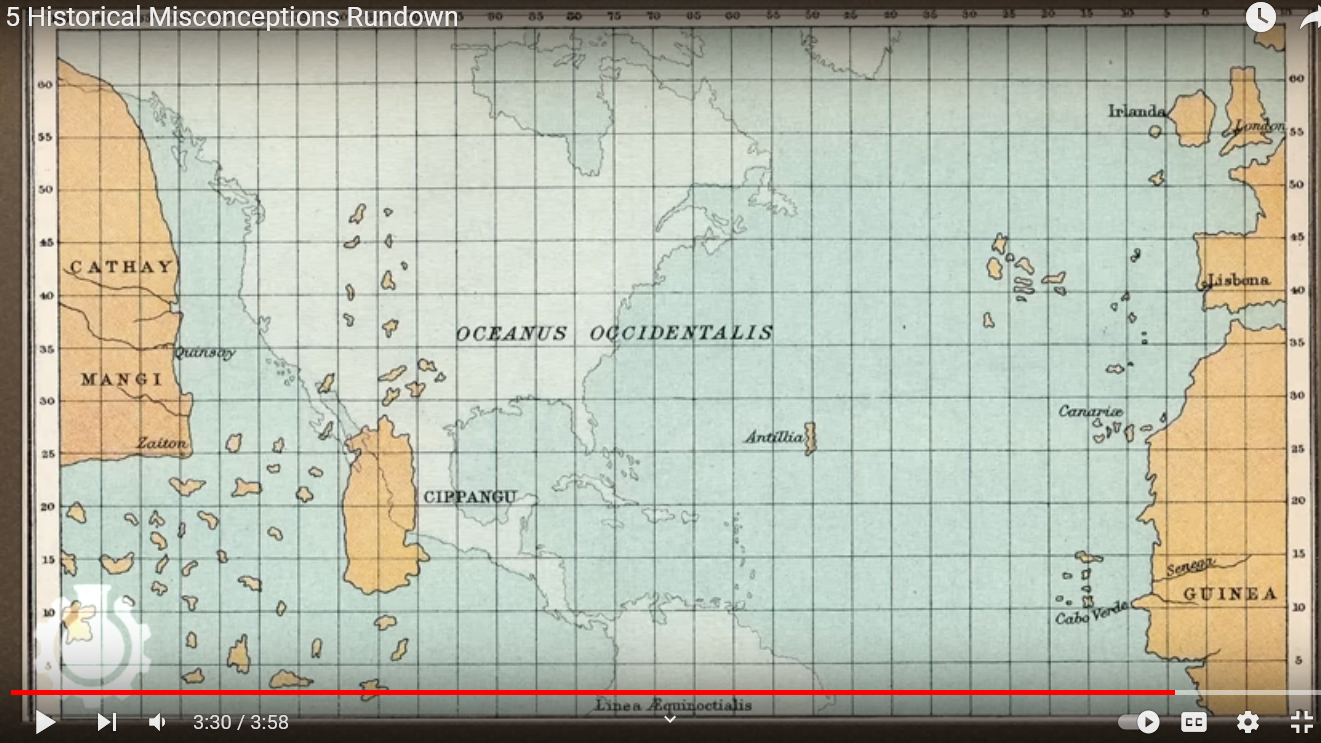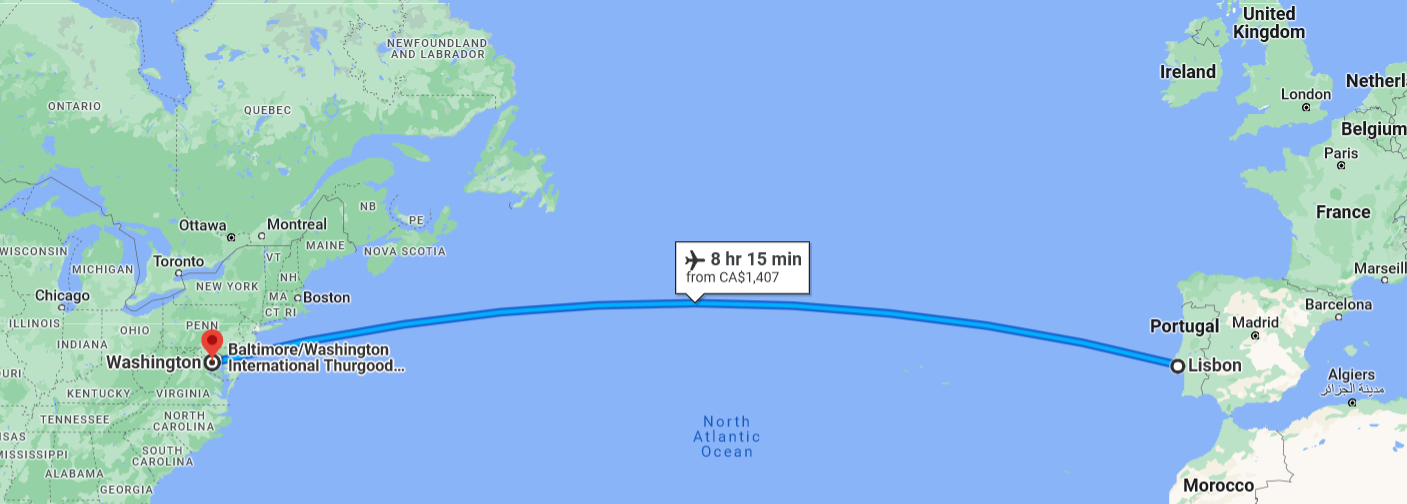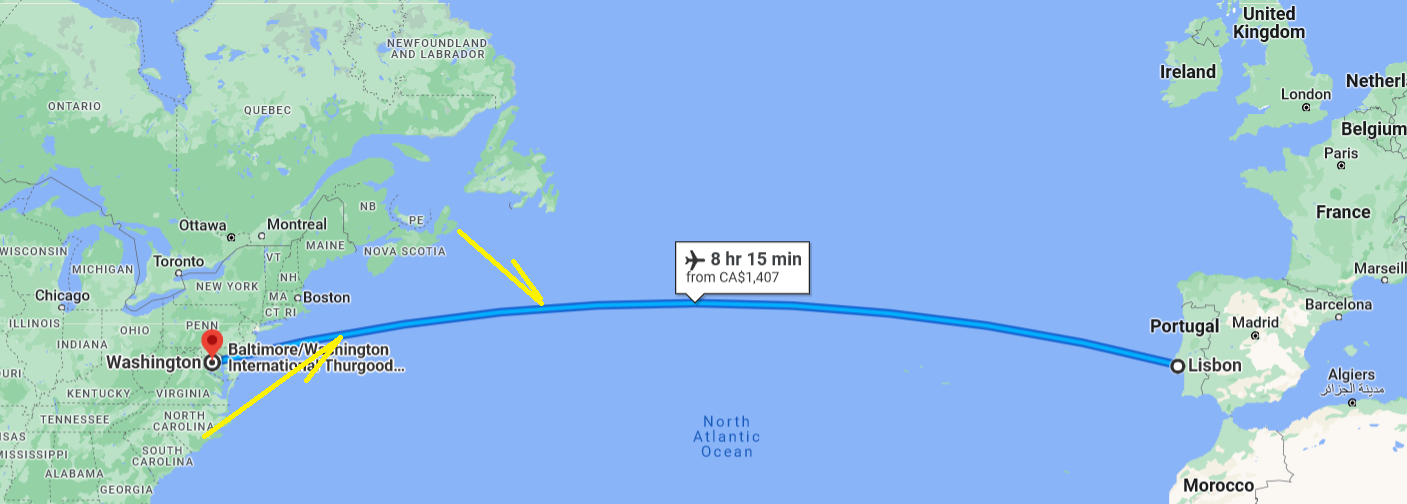709-218-7927 The Landfall Garden House 60 Canon Bayley Road Bonavista, Newfoundland CANADA A0C 1B0 |
|---|
How to Discover the New World from Lisbon and Return to Tell the Tale
It’s a piece of cake, if you think about it.
A few rational assumptions:-
(1) You are the owner, master, captain of a wooden sailing vessel about a thousand years ago and you have the cash or a sponsor for the cash for a voyage of up to one year.
(2) Lisbon Portugal is your home port, but choose any other port on the edge of what we now know to be a vast ocean. San Diego? Lima? Buenos Aires? Perth? Sydney? Liverpool?
(3) Your mission is to report back to your sponsor or home-port on a new land, no matter how far away it is.
(4) You know that Greek astronomer Eratosthenes in the 3rd century BC determined that Earth was a sphere with a circumference of about 250,000 stadia.


Above is shown a Google Maps conception of a direct air flight between Lisbon and Washington. I have purposely cut off the area of The Gulf Of Mexico.
For this example we assume that you plan to set sail from Lisbon on mid-summer’s day and head due West.
Before leaving harbour you align your ship due East, the direction you want to be heading on your return from “out there”, and you scribe on the deck the point where the noon-time shadow of the mast falls on the deck. Actually, you scribe the mark of a yard-arm, for the top of the mast is so tall that it will cast a shadow on the water.
You reason that no matter where you end up, if you are close to your home port on midsummer’s day, the shadow of the mast must fall on the scribed mark. That is, on midsummer’s day in Lisbon, every year, that scribe and the shadow should match.
Of course at different times of the year the shadow will fall in a different position, so you mark six additional places, one for each of the 21st day of each month July through December. Now you have seven marks, one for each day of a twelve-month year, for the mark on July 21st will coincide with that for May 21st, and August/April will coincide, and so on. You can interpolate between two marks for any other day within a month.
You set off heading due West on any day that suits you; or if you prefer, you can head slightly north or south of west and maintain the track dictated by the shadow marks on your deck. You know that you must come across a landmass, either a landmass previously unknown, or the eastern shores of your home continent. Based on our current knowledge you would reach Chesapeake Bay, but if the Americas were not there, you would land in Korea, which is the eastern shore of Lisbon’s continent.
On the day you reach land, you scribe the noon-time shadow of the mast on the deck to record the “position” of your landfall. You then explore north and/or south up and down the coast recording in sketches and in words the significant features visible from the ship.
Significant rivers are important, for they represent a supply of drinking water and avenues to the interior of the new land and, perhaps, a chance to secure fresh meat protein.
You locate significant rivers as a shipmate calls out whenever the ship rides lower in the water, for this means that the water is locally less dense, contains less salt, is fresh water, and that usually means a significant river is flowing into the ocean nearby. Think Mississippi or Columbia or Amazon or ...

The yellow arrows represent short-cuts back to your Lisbon-latitude at the end of a northerly or southerly exploration. Initially heading south-east of north-east greatly reduces your travel time to return to Lisbon.
Keeping an eye on your provisions, you turn around and head back East, tracking a little to the south/north to reach your original track. You will know when you are on track for Lisbon when the scribing on your chart matches the noon-time shadow of the mast on the deck. After that you merely head in an easterly trend, maintaining a course that keeps your noon-time shadow of the mast synchronized with your chart.
What If the Deck Markings Get Scrubbed Off By Feet?
Of course, you don’t mark the actual deck, for that would disseminate valuable data. You mark the position on a scroll which is otherwise held in a locked box in your locked cabin, for this data is valuable to your sponsor back home. At noon once a week, you walk to the deck with the scroll under your arm, unroll it on the deck, check or make marks, and then return the scroll to your cabin.
Where Exactly is Lisbon on the Coast of Portugal?
On the return trip, you do not need to make landfall in Lisbon harbour; your crew members are from Lisbon and the region around there, up and down the coast for seventy miles or so. Seventy miles is one degree of latitude. One of your crew will identify his home town and advise you to head North (or maybe South) to reach Lisbon in a day or two.
As well, as a ship’s master your have ranged up and down the coast of Portugal and much of Spain for years, so you know the major landmarks along the coast.
Welcome Home!
When is it Noon At Some Indeterminate Place on the Ocean?
By definition Noon, or Mid-day, is marked locally when the sun reaches its highest point in the sky. If clouds hide the sun, just wait until the next day. The ship is at sea, and although you might choose to reef (or is it “furl”) sail and have the ship lie still for a half-hour or so, the gentle swell will rock the ship from side to side and thus the shadow of the mast will trace a line back and forth across the deck.
Out with a piece of chalk, and mark the furthest limits of this oscillating path on the deck. Note the most northerly mark on the deck (the ship is pointing to the west) and the most southerly mark, then find the mid-point. That will serve as a suitable average position for the noon-time shadow of the mast.
709-218-7927 CPRGreaves@gmail.com Bonavista, Monday, February 26, 2024 2:09 PM Copyright © 1990-2024 Chris Greaves. All Rights Reserved. |
|---|